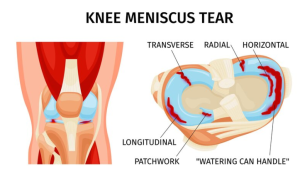What is a torn meniscus?
 Different types of meniscal tears, depending on location and orientation
Different types of meniscal tears, depending on location and orientation
The meniscus is a C shaped fibrocartilage in our knee joints, located between the tibia and femur. Importantly, they work as shock absorbers for the knee joint. Our knees are weightbearing joints and as a result, must withstand a lot of force. On each side of our body, we have one meniscus on the inside (medial), and one on the outside (lateral). Unfortunately, the medial meniscus tear is more common torn. Especially, in individuals who play contact sports and high impact sports.
How does a torn meniscus happen?
Usually, meniscal tears are traumatic, you can pinpoint the moment in time that the injury occurred. However, in rarer cases they can be insidious and feel like they happen without your knowledge. One of the main methods of injury are sports, a forceful direct impact or a sudden twist while foot is planted on the ground. Additionally, the incidence rate of meniscus injuries increases with age.
What are the risk factors?
- Overuse
- Osteoarthritis (OA)
- Obesity
- Age
- ACL injury
- Previous knee injuries, especially if they were traumatic
Signs and Symptoms:
It is important to note that meniscal tears often happen in conjunction with other knee injuries such as ligament strains/sprains. As a result, the symptoms often overlap with other each other.
- Decreased and painful range of motion
- Knee feels like it will give out
- Popping sensation at the time of injury
- Joint swelling
- Crepitus
- Locking in knee
- Pain around knee joint
- Stiffness
- Antalgic gait ex. limping
- Pain increases with weightbearing activity like walking, stairs and squats
Diagnosis:
After taking a detailed history about the pain and injury history, your health care practitioner will conduct a physical examination for your knees. They will check your range of motion, strength, integrity of the joints, check your sensation, balance, and more. Then, they might send you for further investigations like x-rays, ultrasound or MRI if they think it is warranted.
Physiotherapy Treatment for a Torn Meniscus
Oftentimes, people think that meniscal injuries will heal over time on their own. In reality, the recovery process purely depends on the type and severity of the injury and symptoms being experienced. It is always recommended to be seen by a health care professional and undergo physical therapy to rehabilitate your knee after an injury. Ultimately, this will ensure your knee gets the proper care it needs and nothing severe will be missed.
1. RICE Protocol
- Rest: First, let the injured knee rest by putting less weight/pressure on it
- Ice: Additionally, use an icepack around your knees several times a day for 15-20 mins
- Compression: Importantly, will help to reduce the swelling around knee joint.
- Elevation: Lastly, rest your leg using a pillow or something similar to keep it elevated and minimize swelling
2. Protective Equipment:
Braces and crutches may be used depending on the severity of symptoms. Ultimately, they will help protect the joint and prevent the injury from worsening.3. Modalities:
3. Modalities
Modalities such as electrotherapy (IFC, TENS), ultrasound, and laser therapy may help decrease inflammation, manage pain, and help with the healing process.
4. Exercise Therapy:
As quickly as possible, we want to restore as close to normal range of motion in the knee. Then, strengthening of those muscles will make the knee stronger to resist future injuries.
- Low impact exercises for cardiovascular training ex. biking
- Isometrics exercises
- Range of motion exercise
- Stretching
- Strengthening exercise of the joint muscles and areas around such as the hips, back and pelvic muscles:
- Functional activity (ex. stairs, squatting, job specific tasks)
- Balance and coordination training
5. Surgical procedure
Finally, in some severe cases, physiotherapy may not be enough to fully rehabilitate your knee, especially if the joint is being blocked by the tear. Thus, a consult with an orthopedic surgeon may be necessary to determine future treatment options for your knee. The meniscus may be able to be repaired, or you may require a partial/complete meniscectomy (removal of a part of the full meniscus).
If you are experiencing a knee pain or torn meniscus that is limiting you, look for PhysioNow! We have many experienced Physiotherapists across the GTA from Burlington to Etobicoke that can help you feel better. Book with PhysioNow today for your first assessment and treatment.





Leave a Reply